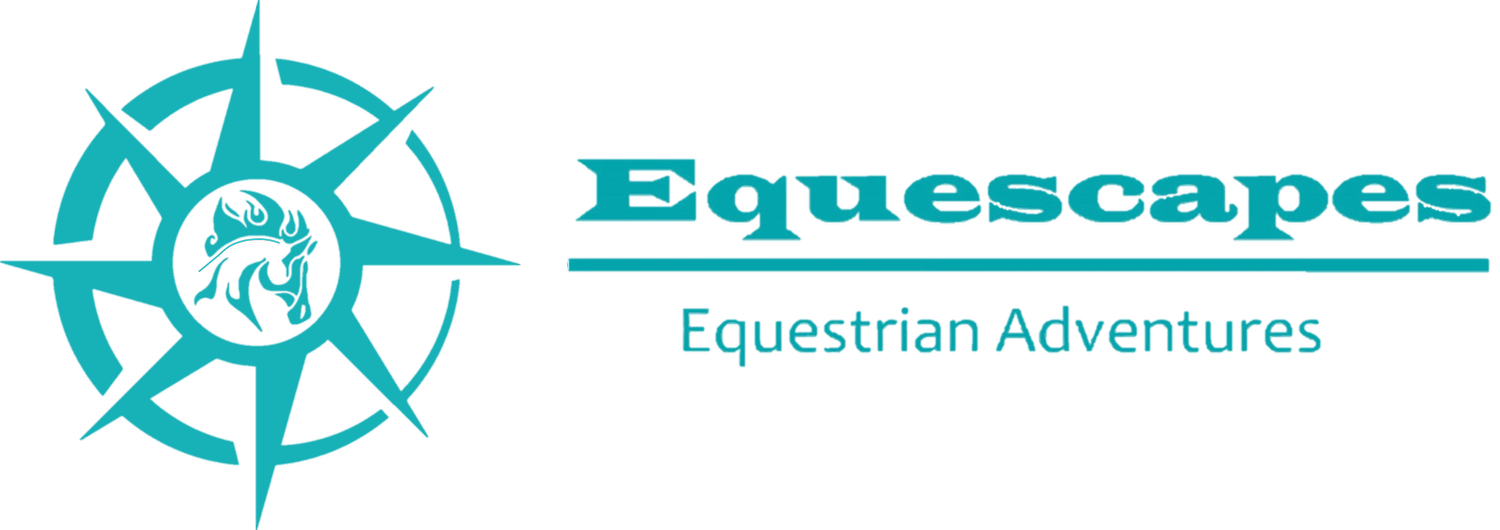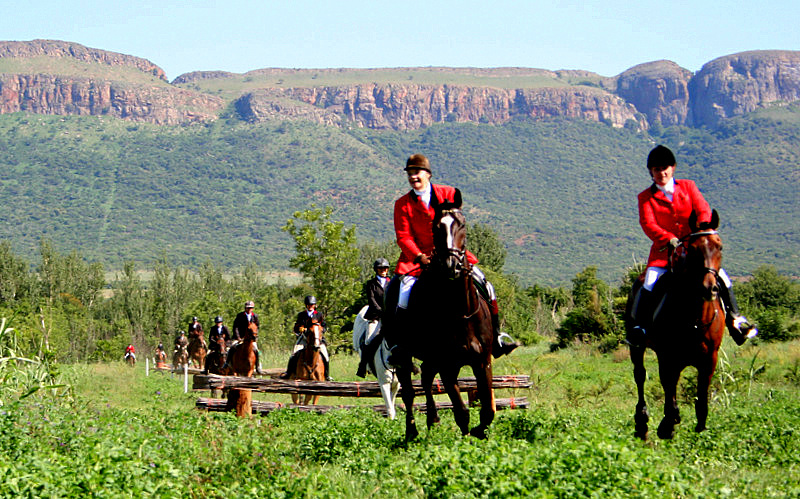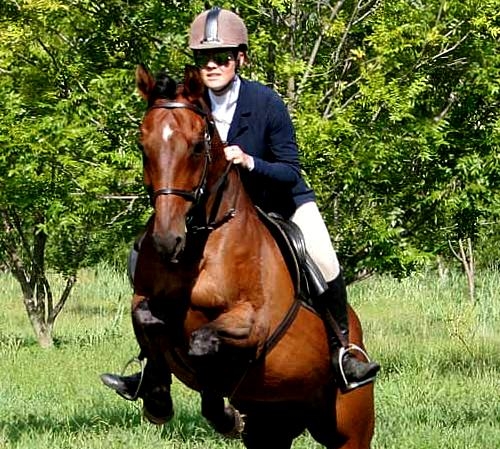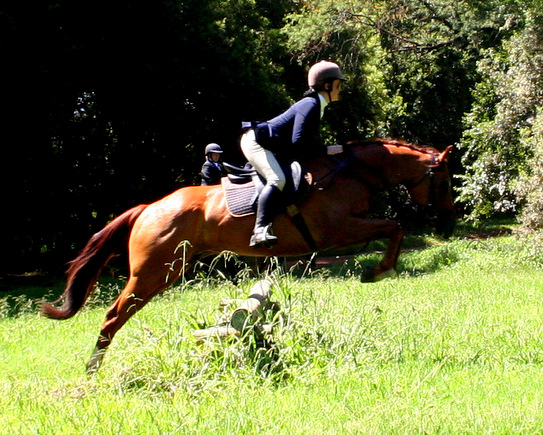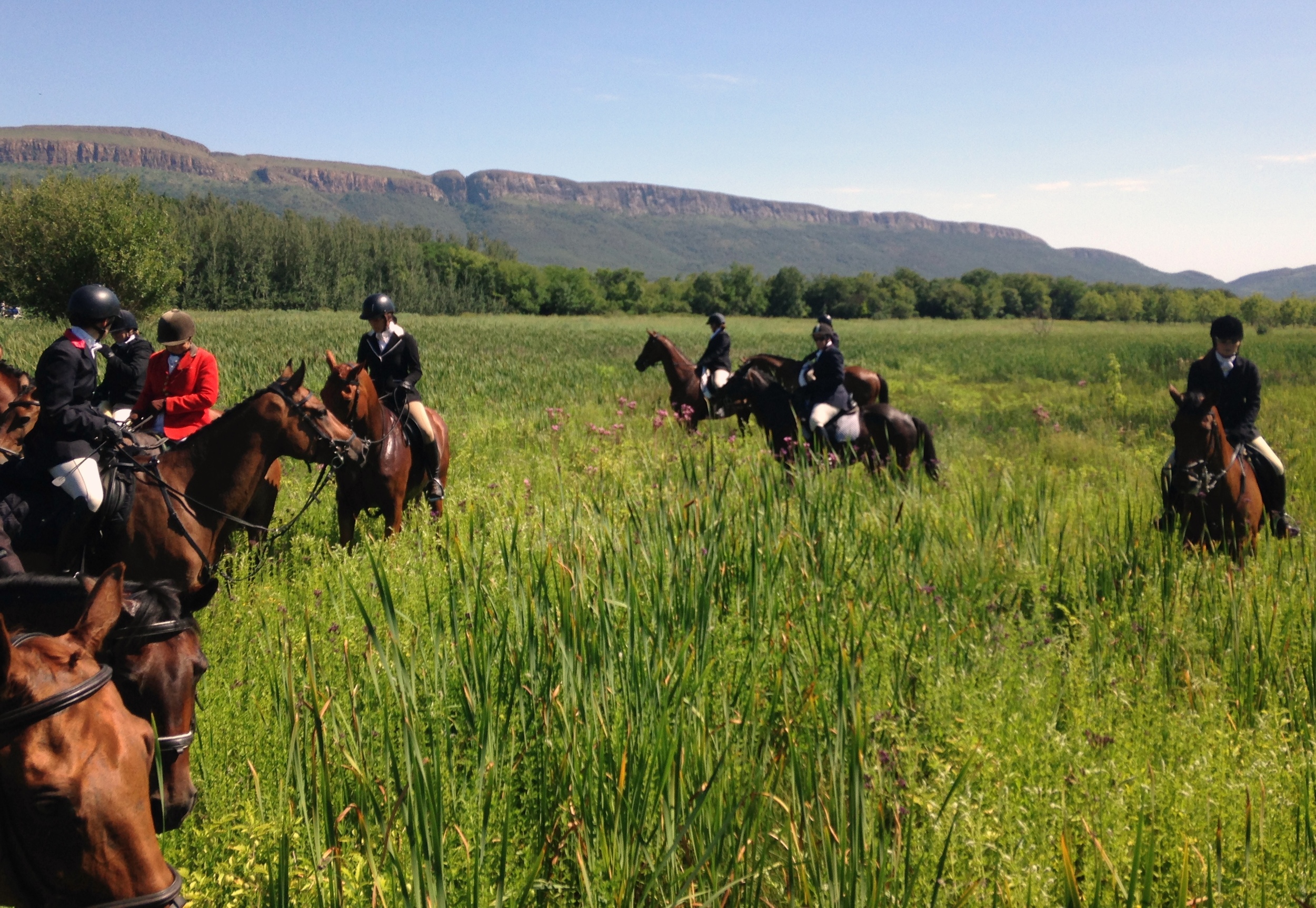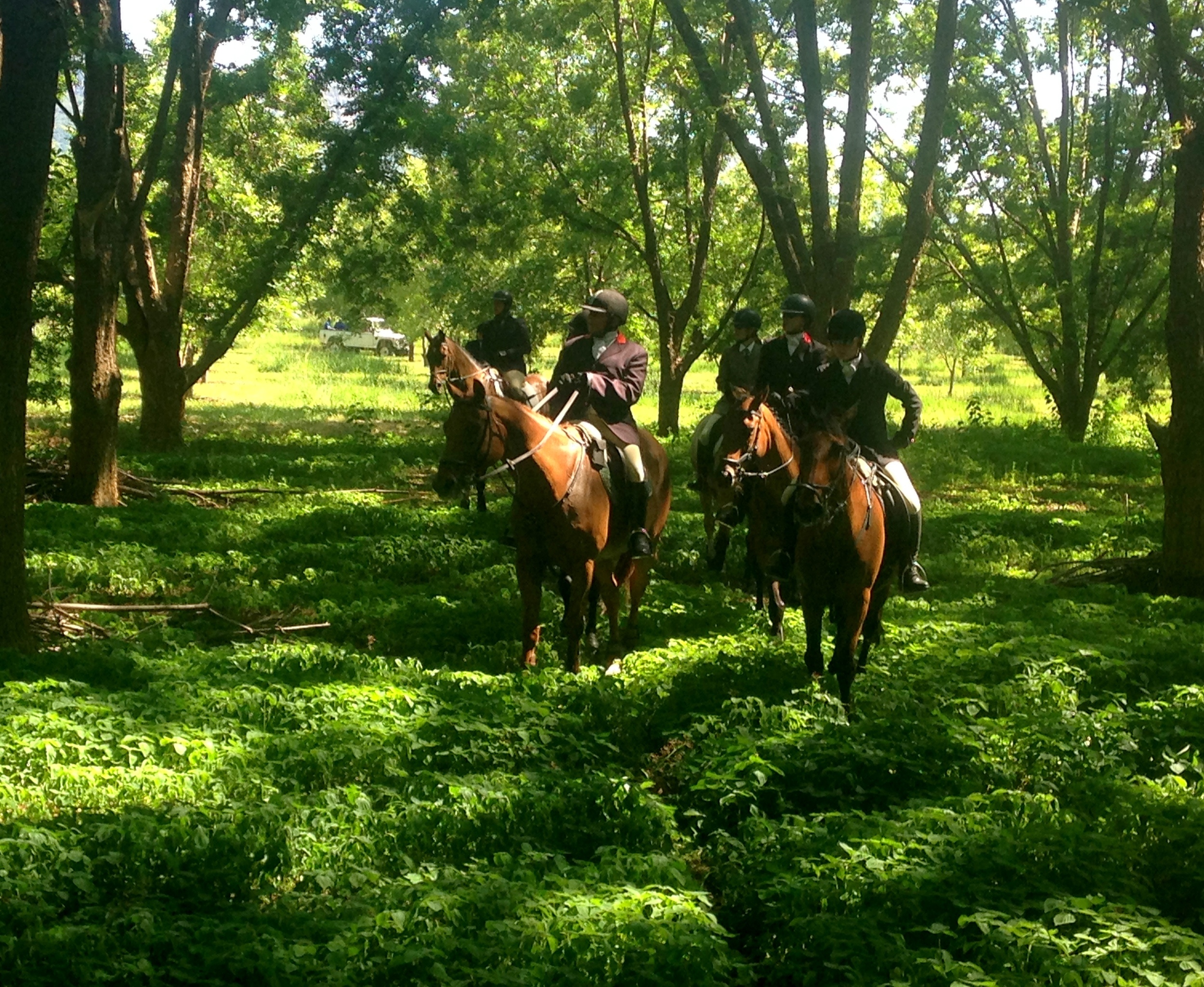Pursuit of the Jackal
Sunlight flickered through the canopy of the pecan trees as we galloped through the orchard, closed branches overhead forming arches like a cathedral. The soft ground, carpeted in green vines, muffled our hoof beats. A pile of large logs ahead spanned the gap between the trees, and the riders in red and black jumped it one by one, like deer over a fence. Cordite never missed a beat; with ears pricked forward, he was smooth and steady to the jump, bounding over it effortlessly, and we were momentarily immersed in sunlight as we came out into the meadow at the end of the row before careening around a bend and entering the dim shade of the forest.
The Rand Hunt is the oldest hunt in South Africa, formed in 1886 with a pack of English Foxhounds from Queen Victoria’s Royal Buckhounds. The hunt is often held at the Inanda Club, where the hounds are housed and the hunt has been based since 1934 in Kylami, the horse capital of South Africa, where riding centers, stud farms, and exquisite equestrian estates abound.
By the Sunday of the hunt, I had been in South Africa for nearly a week, much of which had been spent in the saddle. I schooled youngsters with Jimmy on his farm every morning, and my afternoons were chock-full of activities involving fellow members of the hunt, from setting up the jumps we would be hunting over to spending an afternoon at the races in Johannesburg. Every hour of each day was filled with horses and I was surrounded by horse people, allowing me to ask a million questions about the hunt and giving me a vague idea as to what to expect on Sunday. It has been my experience though, that foxhunting is never uneventful, and it’s the uncertainty that is part of the thrill.
The hunt began promptly at eight, at the Astley Manor Pecan Farm in Skeerpoort. I began the hunt on a beautiful bay thoroughbred, Cando, known during his racing career as “I Can Do It.” I say beganbecause I actually finished the hunt on a different mount. Both belonged to Penny, a member of the hunt whom I had met while in South Africa the previous year. As fellow hunt enthusiasts, we had kept in touch, and it was she who invited me to participate in the hunt and coordinated my stay at Jimmy’s farm, in addition to very graciously offering me her lovely horse to ride. When I rode Cando the previous morning in a lesson with Penny’s trainer, she had warned me that although he had won Horse of the Year the previous season, and I had seen beautiful photos of her jumping him while donning her formal hunt regalia, he was not as easy as he looked and had a mind of his own when it came to jumping. All that aside, he was calm and composed while we warmed up and the hounds were gathered by Margie, the hunt master. Penny rode her other horse, Cordite, formally known as “Cannon’n Cordite,” and took the drag, the jackal scent which the hounds follow as they lead the riders through the course, which consisted of five pre-established lines. Penny would get a five minute head start with the drag on each line, leading the hounds through the chase, and after each line the hunt would regroup before the next.
As soon as the hounds were gathered and the horn blew, they were off like a shot, with Margie and the whips in rapid succession, followed by the first field at a gallop. Jimmy and I hung back and rode the first line in the second field at a trot. Not ten seconds into the first line, we came to a stop as riders struggled to convince their horses across a ditch. Cando stepped over nonchalantly and continued unfazed, as if wondering what all the fuss was about. Not long after, we crossed a rider back-tracking, looking for Margie’s hunt cap, which had come off when her horse tripped going through the very same ditch. Her cap was located and our group took off again, this time at a canter. I nearly went down when Cando stepped in a hole where an old tree had been dug out, but he righted himself right away. Another rider was not so lucky, falling off when his horse dodged a tree to the right and he went left.
As we cantered between rows of pecan trees, we came to the first two jumps, both of which Cando refused. We were riding in the middle of a pack, and Penny had warned me that he doesn’t like to jump when he has horses next to him, but it was the horses next to me who prevented me from being able to go around. The hunt regathered at a watering hole for the hounds, a bathtub, in which they took turns drinking, splashing, and laying down. The car-followers, in three vehicles, caught up and provided sips of ice water or gin and tonics for the riders before moving on to get set up at their viewing point along the next line. Penny suggested I bring Cando around a second time if he refused the next jump. Since she usually either hunts the hounds or rides at the front of the field when she rides him, she doesn’t ever have the opportunity to school him when he refuses, so he’s learned he can get away with it.
This time the hounds left before the horn was blown. A few burst loose from the grooms holding them, so the hunt waited while the master and whips tore after them and herded them back, shouting and galloping about. Many of the horses, clearly used to the routine, jigged and pranced in anticipation as the hounds were brought back, waiting for the horn, which was blown as soon as everything was back in order and the hunt exploded into motion once again. We had quite a long trot and canter through a field of young, small pecan trees before coming to more jumps, this time in a fence line so there was no option to go around. Cando refused the first one, and we were forced to circle back to take it again, which he did, encouraged by a smack on the rump from my crop. He cleared the coop by at least a meter, and I nearly came right out of the saddle. Over the next fence, he made it clear he wasn’t stopping but jumped even higher.
At the end of the line we caught up with the hunt again and Penny was having quite a bit of trouble with Cordite. He was objecting to taking the drag and being away from the other horses, and he fussed around and caused her to drop the drag line, which had caused some problems when the hounds caught up to her. So she needed to switch horses with me in order to take the drag on Cando, her steadier mount. Cordite was much younger and greener, and had been ridden by no one but Penny in the few years since he had come off the track. He had an unpredictable streak and ran a bit hot, and along the third line Jimmy and I had set up quite a few jumps, bigger than the last few, so I had had some hesitations about riding them on Cando, let alone Cordite. I skipped the jumps on that line, as I got a feel for my new mount, and was disappointed not to be in the first field, where I could have seen Jimmy, who had been so excited all week to try his lovely jumps. I’m sure Inca, Jimmy’s thoroughbred, had no trouble with them, although the line of seven jumps did put one or two other riders on the ground. Cordite was lovely, and settled down greatly by the time the hunt regathered again, and only got better and better as the hunt continued. On the final line he was flawless, a perfect gentleman, steady, soft, and smooth. He took every jump without question, slowed down and sped up when asked, and by the time we dismounted and gathered for breakfast, I couldn’t have been happier.
“Well, how was he?” asked Penny.
“Take a guess, from the smile on my face,” I said. At the races, I had heard horror stories about what a terror he had been to ride as a racehorse, but he rode for me like he was born to hunt.
Each and every hunt has its own customs and traditions, some of which are more obvious than others. I took off my hunt coat as soon as I dismounted, hot as it was, before I noticed everyone else still had theirs on. When I inquired, Penny told me we weren’t supposed to take ours off until Margie, the master, did so, and as more riders arrived at the breakfast still wearing their coats, I put mine back on. When asked when she would take hers off, Margie just giggled mischievously. When she finally did remove her red coat, she said to me, “I was waiting for someone to tell you.”
The horses were handed to the grooms to untack, water, and brush, while breakfast took place under a shade tent at the edge of the oldest pecan trees. The spread consisted of traditional Boerewors sausages, grilled and served on rolls with sweet chili sauce. At the bar, built into a trailer, gin and tonic was the standard après-hunt beverage. Jimmy, Penny, and I were among the last to leave, sitting around in the pecan tree shade telling stories and comparing our various hunting experiences.
Each and every hunt is different—not just each hunt club, or hunting location but each and every single day of hunting is unique, and never without incident. But every hunt I’ve ever been to has something in common, and it’s so much more than just the thrill of the chase, the baying of the hounds, and the formal English attire. I am always welcomed as part of the family, because above all else, foxhunting is a community, a society dedicated to the preservation of a historical tradition which transcends generations and borders.
